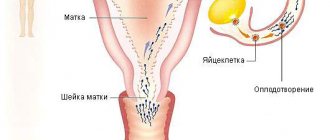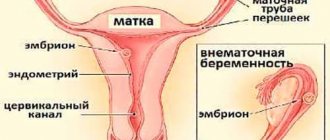Reasons for conception with an IUD installed
Photo: prolapse or displacement of the IUD
There are not so many of them:
- Displacement or prolapse of the intrauterine device. The intrauterine device provides only mechanical protection, so conception is possible with slight changes in the position of the device.
- Expiration of the intrauterine contraceptive. Termination of the contraceptive effect when using the device for longer than the time prescribed in the instructions.
- Incorrect installation of a contraceptive. If you use an intrauterine device, you need to visit a gynecologist twice a year to be sure of your own protection.
Are the signs of pregnancy with an IUD different from normal?
The symptoms of pregnancy with an IUD are identical to those of a normal pregnancy!
The main symptom is the absence of menstruation, as with normal conception. There may also be scanty spotting similar to menstruation. There are also secondary signs - swelling and tenderness of the mammary glands, nausea, vomiting, there may be a nagging pain in the lower abdomen, mood changes, changes in appetite.
How to most accurately determine whether there is a pregnancy?
First, take a pregnancy test. If the test is uninformative or uninformative, then you can donate blood for hCG (human chorionic gonadotropin).
Important! The sooner you diagnose a pregnancy with an IUD, the better! The initial symptoms of ectopic and uterine pregnancies are the same!
Secondly, it is imperative to visit a gynecologist for any change in the menstrual cycle. Only he will be able to determine the location of the fertilized egg.
Symptoms of ectopic pregnancy
- Spotting bloody discharge from the genital tract. There may be scarlet or brown, but not similar to menstrual discharge;
- Pain in the lower abdomen. Pulling or strong, and can also be sharp with certain movements;
- Malaise, general weakness;
- Increased body temperature.
Important! If you have any signs of an ectopic pregnancy, you should consult a gynecologist.
Only a gynecologist can determine the location of the ovum through examination. When the fertilized egg is located outside the uterus, its size does not correspond to the period of delay. The ectopic pregnancy itself is usually not palpable and is confirmed by ultrasound. Once a diagnosis is made, the woman must be hospitalized.
What to do if pregnancy occurs?
- If the pregnancy is ectopic, then urgent hospitalization is necessary. In a hospital, the tube containing the fertilized egg is removed through laparoscopic or abdominal surgery.
- If the pregnancy is intrauterine, then you should decide whether to keep the baby or not. But only after consulting a gynecologist.
How long can you drill on weekends?
The time from which renovations in apartments are prohibited on Saturdays differs for different regions simply because it happened that way. There is no point in looking for any objective reasons for specific numbers for a weekend. In most cases there are none.
Noise levels
The difference from when and until what time it is allowed to carry out drilling or repairs on a day off is explained only by the fact that these are different regions, and the laws in them were adopted independently of each other.
This must be taken into account when planning work.
How long can repairs be done on weekends?
The table below shows the times when repairs can be done on Saturdays. Drilling is also allowed during these hours. On Sundays and holidays, noisy renovations in an apartment are prohibited throughout Russia.
| Moscow and Moscow region | It is forbidden |
| St. Petersburg and Leningrad region | From 12 to 22 |
| Komi Republic | It is forbidden |
| Sverdlovsk region | From 11 to 18 |
| Novosibirsk | From 9 to 22 |
| Omsk | From 8 to 22 |
| Tomsk | From 9 to 23 |
| Ekaterinburg | From 11 to 18 |
| Kazan | It is forbidden |
| Penza | From 10 to 22 |
| Kaliningrad | From 8 to 19 |
| Kirov | From 7 to 22 |
| Samara | From 10 to 22 |
| Lipetsk | It is forbidden |
| Nizhny Novgorod and Nizhny Novgorod region. | From 10 to 22 |
| Arkhangelsk | It is forbidden |
| Ufa and Bashkortostan | It is forbidden |
| Belgorod | From 10 to 20 |
| Izhevsk | From 7 to 23 |
| Vologda Region | From 7 to 22 |
| Volgograd | From 7 to 22 |
| Nizhnevartovsk | From 8 to 21 |
| Vladivostok | From 10 to 23 |
| Amur region | It is forbidden |
| Altai region | It is forbidden |
| Krasnoyarsk | It is forbidden |
| Krasnodar and Krasnodar region | It is forbidden |
| Voronezh | From 10 to 22 |
| Khabarovsk | From 8 to 22 |
| Vladimir | From 8 to 22 |
| Murmansk region | From 12 to 23 |
| Irkutsk | It is forbidden |
| Kursk | From 8 to 20 |
| Permian | From 9 to 22 |
| Eagle | From 10 to 23 |
| Orenburg | From 8 to 22 |
| Saratov and Saratov region | It is forbidden |
| Tula | From 7 to 22 |
| Tyumen | It is forbidden |
| Rostov | From 10 to 22 |
| Ryazan | It is forbidden |
| Chelyabinsk | From 8 to 22 |
| Ulyanovsk | It is forbidden |
| Yaroslavl | It is forbidden |
What to do - interrupt or prepare for childbirth?
If you do not want or are afraid to give birth, then the problem is solved with the help of an artificial abortion. During this procedure, the IUD is also removed.
If a woman decides to carry a child, she must listen to her body throughout the pregnancy and consult a doctor at the slightest discomfort..
When using an intrauterine hormonal system, it should be removed from the uterine cavity as carefully as possible.
Hormones contained in the intrauterine contraceptive device can affect the formation of organs in the fetus.
The doctor removes the drug in a hospital setting, then the further development of the fetus and the woman’s condition are observed for a short time.
In rare cases, it is recommended to remove the non-hormonal IUD. The infection can penetrate through the threads, or tendrils, into the uterus and, accordingly, to the fetus. If milky discharge increases, as well as discharge with an odor, you should contact your doctor.
How to officially get a title for a pit bike?
Any vehicle with an engine capacity of over 50 cubic meters must have a title when traveling on public roads. Initially, a pitbike is sports equipment and there is no technical passport for it; upon purchase, you are issued a receipt and an agreement, which states that the motorcycle is not intended for riding on public roads.
You can go through government certification, which will check your purchase documents, technical specifications, and whether the bike meets safety standards (i.e., whether it has all the necessary electronics, lights, and sounds).
The examination procedure is paid, plus you will have to invest heavily in installing all the equipment. However, after this you have absolutely no fear of problems with the law and meetings with traffic cops.
Consequences of pregnancy with the IUD
Why is it dangerous to carry a baby with an IUD in the uterus and is it possible for a woman to give birth?
The possibility of miscarriage during pregnancy with an IUD is higher than during a normal pregnancy. The spiral is a foreign body and the body will try to get rid of it, and, accordingly, the fertilized egg. Therefore, if vaginal discharge begins, you should visit an antenatal clinic. If the discharge is accompanied by pain in the lower abdomen, then immediately call an ambulance and be observed in a hospital.
Important! It is possible to carry and give birth to a healthy child during pregnancy with the IUD.
According to statistics, if a miscarriage does not occur in the first trimester, then there is no further concern for the child’s development. The fetus grows and can push out the contraceptive itself.
Principles of operation of intrauterine contraceptives
Nowadays, intrauterine contraceptives (IUDs) are made of plastic with the addition of various metals (copper, gold, silver) and hormones (progesterone derivatives).
The mechanism of action of IUDs is not completely clear. However, they are not known to affect ovulation or sex hormone production. IUDs prevent conception in the following ways:
- disrupt the implantation of a fertilized egg, injuring the wall of the uterus;
- stimulate excessive contractile activity of the uterus, which leads to expulsion of the fertilized egg in very early stages of pregnancy;
- enhance peristaltic contractions of the fallopian tubes, which leads to accelerated movement of the fertilized egg, as a result of which it ends up in the uterus at a stage when it is not yet ready for implantation;
- by changing the contractile activity of the uterus and fallopian tubes, they impede the advancement of sperm, that is, probably in some cases they can interfere with fertilization itself.
In addition, the metals contained in the IUD have a spermotoxic effect, that is, they have a detrimental effect on sperm, and progesterone derivatives change the local hormonal levels, which also prevents embryo implantation.
There are three types of intrauterine contraceptives: the copper IUD, the intrauterine progesterone-releasing system (PRS), and the levonorgestrel-releasing intrauterine system (LRS). Copper spirals (their service life is from 2 to 5 years, depending on the thickness of the copper wire) are the most widely used in the world. The mechanism of their action is associated with the spermicidal activity of copper and the reaction of the endometrium to a foreign body, which disrupts the processes of fertilization and implantation. ORS mainly provide their contraceptive effect by changing the properties of cervical (cervical) mucus and the reaction of the endometrium to a foreign body. These systems are often used not only as contraceptives (their validity period is about 12 months), but also as a remedy for various hormonal disorders in the gynecological field. One of the latest achievements in the field of intrauterine contraception was the creation of an LRS, the contraceptive effect of which lasts for 5-7 years. MRS, just like ORS, affect the endometrium (the reaction of which to a foreign body prevents the implantation of a fertilized egg), increases the viscosity of mucus in the cervical canal, which prevents the penetration of sperm into the uterine cavity.
In addition, LRS can cause excess production of a special substance - glycodelin-A - in the endometrium, which, when entering the fallopian tubes, has a local contraceptive effect, preventing the attachment of the sperm to the egg. LRS leads to a decrease in the number of receptors for estrogen and progesterone in the uterus, which again interferes with implantation.
In general, summing up all of the above, we can say that the main mechanism of action of the IUD is a violation of the delicate balance of all local factors that ensure the normal development of pregnancy in its earliest stages. It is important to note that all these changes are reversible.
How to protect yourself as much as possible from unwanted conception if you have an IUD?
- It is necessary to follow the rules when using an intrauterine contraceptive.
- Change the method to a new one or another method of contraception in a timely manner.
- Visit a gynecologist twice a year.
- Independently check for the presence of antennae coming out of the cervix. If the antennae have become longer, this may indicate that the product has moved or fallen out.
It should be remembered that conception in women with an IUD installed occurs only in one or two cases out of a hundred. The intrauterine contraceptive is one of the most reliable means of protection against unwanted pregnancy.
On women's forums you can often come across negative reviews about the IUD. But most of them are associated with the incorrect use of this product.
Reliability and safety of intrauterine contraceptives
Intrauterine contraception is considered a reliable (on average 1-2 pregnancies per 100 women 2 per year) method that provides immediate (from the moment of insertion) and long-term (from 1 to 7 years, depending on the type of device) contraceptive effect. After removal of the IUD, the ability to conceive is quickly restored (in a third of women, pregnancy occurs within the first month after removal of the IUD). IUD does not affect sexual intercourse in any way. It can be used while breastfeeding.
Before using an IUD, it is necessary to conduct a gynecological examination to ensure that there are no contraindications for its insertion, which include:
- pregnancy or suspicion of pregnancy;
- chronic or acute inflammatory diseases of the pelvic organs;
- infections of the cervix or pelvic organs, including sexually transmitted diseases;
- episodes of pelvic inflammatory disease or endometriosis less than three months before IUD insertion;
- tumor diseases;
- anemia, blood clotting disorders;
- uterine bleeding of unknown origin;
- abnormalities in the structure of the uterus;
- severe diseases of internal organs (for example, heart defects).
Intrauterine contraception is not recommended for nulliparous women, or for women who have more than one sexual partner, or if a woman's partner has more than one partner (IUDs do not protect against sexually transmitted infections).
According to the recommendations of the World Health Organization, IUDs are especially suitable for those women who (of course, in the absence of contraindications) want to use a method that does not require any worries, do not want to have a child soon, have successfully used IUDs in the past, and are breastfeeding. For painful and prolonged menstruation, a progesterone-releasing system may be recommended.
The IUD should only be inserted by a specialist. In the future, when using it, you must follow the instructions given to you by the doctor.










